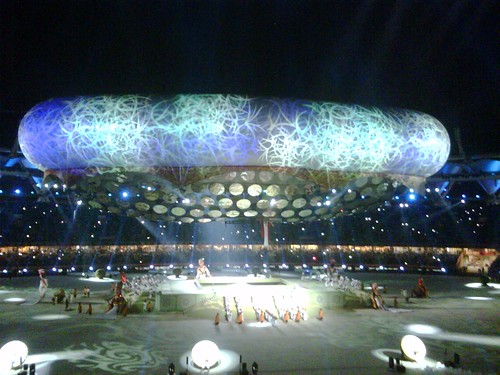I suppose when you're a famous installation artist, second only perhaps to Damien Hirst in terms of popularity but far better in terms of talent, you are allowed to be a bit capricious.
Works by Anish Kapoor, Indian-born, British-based sculpture superstar, are currently on show in Mumbai and Delhi at the Mehboob film studios in Bandra, and the National Gallery of Modern Art respectively.
Now this is a massive, massive deal for India's art world. In fact, organisers first had the idea a decade ago, and only now has it been possible. For starters, there was simply not the exhibition space large enough needed to show his massive works (In Delhi, the NGMA has a capacious new wing where it's showing the sculptures). It is also, as would be expected, an extremely expensive exercise. So to finally be in a position to put on show works by the artist who left India at 18 in his native country, is significant. There are even ads at bus shelters, pasted over the paan stains.
Unfortunately, artists are an unpredictable lot. In the past I've had trouble with artists, in particular one fashion designer who got the shits when I asked him a question about his label's background. He ended the interview after I insisted I needed quotes from him, rather than lifting lines from the briefing notes I'd been given (sample: "Inhouse workshops insure an all-encompassing expression of our vision of beauty"). As the only vaguely usable quote I had from him - "my designs are a synthesis of East and West" - was not going to fill my 450 words, I sent a strongly-worded email to his PR and moved on to profile someone else.
In this case, Kapoor opted to cancel all interviews except for a handful. Now, this is the biggest thing to happen in India this year in arts, so naturally, dozens of journalists were clamouring for access to him. Is he shy? I like to give people the benefit of the doubt and assume that about them, if they're being a little difficult. The British Council, staging the exhibition, said he was concentrating on the preparations for the show beforehand - that is understandable. He would also be leaving Delhi almost immediately after the launch - on November 29 - so wouldn't be speaking to journalists afterwards either.
I was invited to the launch - my best opportunity to "grab Anish for a comment", according to the BC - but didn't go as I was overseas. Today, finally, I went to see the show at the NGMA, at its on sprawling grounds in central Delhi, near India Gate. It costs 150rs for foreigners, 10rs for locals. Inside, there's a string of rooms showing architectural models and sketches of some of Kapoor's large-scale works.
The larger sculptures are in the new wing out the back. The exhibits include the massive red wax quarter-orb that appears slammed against the wall, called Past, Present and Future. It's the most dramatic piece in the room, which also houses a stomach-height perspex cube, with what appears to be a gold stingray and bubbles suspended inside. The name of the work is Laboratory for a New Model. and the exhibition guide tells us that the sculpture "is addressing the weight of human knowledge, from the grand purposes of physics to the more specific concerns of art history." I'm sure it does do that - it must, as the booklet tells us so - but I confess, I couldn't really see how.
I tried taking a photo of the room but as the ratio of security folk to viewers is roughly 1:1, I had little success, just this one:

Close to the mirror you might spot an earnest guard on his way over to berate me.
Outside in the garden is the much-vaunted Sky Mirror, which is mounted a few metres above the ground and tilted at 60 degrees so it reflects the sky on its convex surface.

It would be perfect if there was something going on in the sky, like moving clouds or birds, but all you see is the rather less impressive, tepid blue-grey of Delhi's winter sky. Around the back, however, you realise what it's all about:

There's also a documentary on Kapoor being screened on a loop in the auditorium. In it, the floppy-haired Kapoor is revealed as enthusiastic and likeable, particularly in the bit when they practice firing red wax out of the cannon (Shooting Into The Corner, Mumbai). After the expectoration - leaving bright red splatters reminiscent of paan stains all over the freshly-whitewashed buildings of Connaught Place - he turns around, smiling cheekily at the camera, much like the grown-up boys of Mythbusters. Maybe the cannon ("an active part of the architecture: at once performance, process, painting, installation and sculpture, with the life of the piece being recorded on the walls") is all just a big boy toy with a fancy name.










































